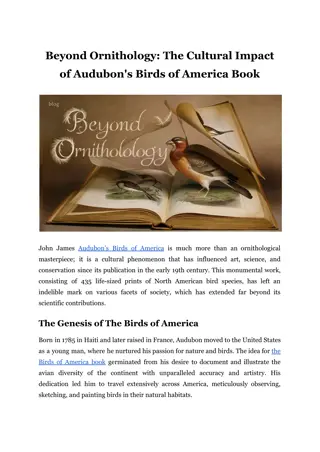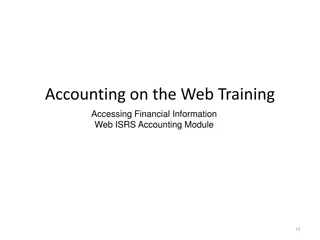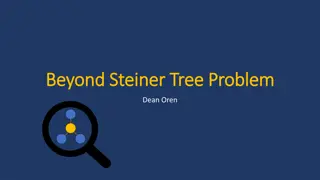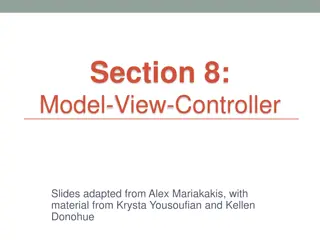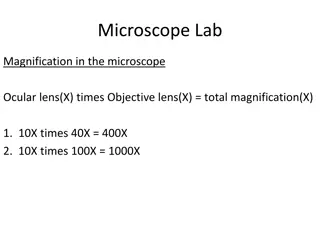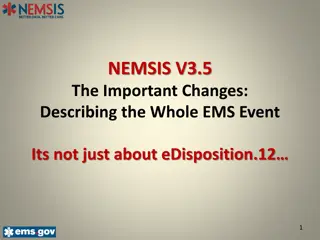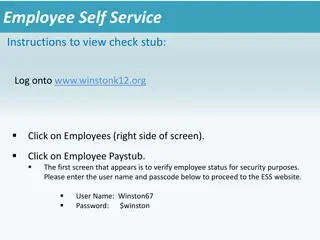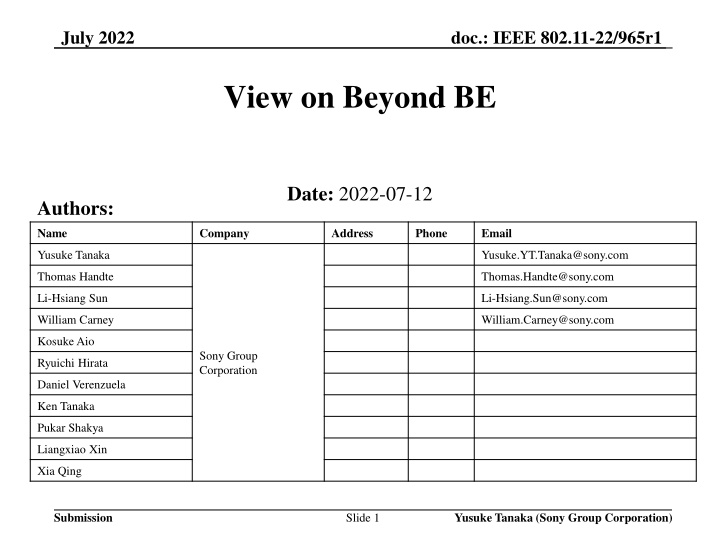
Insights into IEEE 802.11-22/965r1 Beyond BE for Future WLAN Standard
Explore the discussions and considerations surrounding the proposal of the next-generation WLAN standard in IEEE 802.11-22/965r1. Discover the evolving Wi-Fi use cases, requirements, and key points to enhance low latency, reliability, and manage multiple access points. Dive into the crucial aspects of improving low-latency traffic for latency-sensitive applications such as gaming, VR, robotics, and more. Gain valuable insights for establishing a new Study Group in the realm of beyond-BE Wi-Fi offerings.
Download Presentation

Please find below an Image/Link to download the presentation.
The content on the website is provided AS IS for your information and personal use only. It may not be sold, licensed, or shared on other websites without obtaining consent from the author. If you encounter any issues during the download, it is possible that the publisher has removed the file from their server.
You are allowed to download the files provided on this website for personal or commercial use, subject to the condition that they are used lawfully. All files are the property of their respective owners.
The content on the website is provided AS IS for your information and personal use only. It may not be sold, licensed, or shared on other websites without obtaining consent from the author.
E N D
Presentation Transcript
July 2022 doc.: IEEE 802.11-22/965r1 View on Beyond BE Date: 2022-07-12 Authors: Name Company Address Phone Email Yusuke Tanaka Yusuke.YT.Tanaka@sony.com Thomas Handte Thomas.Handte@sony.com Li-Hsiang Sun Li-Hsiang.Sun@sony.com William Carney William.Carney@sony.com Kosuke Aio Sony Group Corporation Ryuichi Hirata Daniel Verenzuela Ken Tanaka Pukar Shakya Liangxiao Xin Xia Qing Submission Yusuke Tanaka (Sony Group Corporation) Slide 1
July 2022 doc.: IEEE 802.11-22/965r1 Introduction Various contributions about proposal of the next generation major WLAN standard have been discussed in the preceding WNG sessions. [1-14] Use cases : XR, metaverse, hybrid work model, gaming, robotics, etc. Requirements : reliability, low latency, throughput, mobility, coverage, etc. The motion texts that propose establishment of the new Study Group were also discussed. It is time to establish the SG considering the discussed timeline. This contribution offers views and considerations that should be cared when establishing a new SG. Submission Yusuke Tanaka (Sony Group Corporation) Slide 2
July 2022 doc.: IEEE 802.11-22/965r1 Use cases in the beyond BE Wi-Fi usage has been constantly evolving, supported by new applications, demands and megatrends. It was further accelerated by the pandemic, and realization in beyond-BE is strongly expected. Robotics Remote work/education XR/metaverse Gaming Online gaming (e.g. FPS) with smartphone, console or PC. Requires quick response to the user s inputs. Immersive VR, enjoying virtual world life. Requires high quality and interactive video corresponding to user s motion. Conferences, classes or diagnostics via video. Requires interactive video, audio and file sharing. Machine control, autonomous vehicle. Requires communication between machines, sensors and cameras. Home (House, Apartment) Enterprise (Office, Factory) Submission Yusuke Tanaka (Sony Group Corporation) Slide 3
July 2022 doc.: IEEE 802.11-22/965r1 Consideration points Considering the use cases shown in the previous slide and discussed in the preceding WNG sessions so far, this contribution offers views on the following three points. 1. Improving low latency 2. Improving reliability 3. Multiple access point environment Submission Yusuke Tanaka (Sony Group Corporation) Slide 4
July 2022 doc.: IEEE 802.11-22/965r1 Improving low-latency Low latency is essential in the future use cases, and it is necessary to consider not only the numerical value but also the characteristics of the traffic. Low-latency traffic is time-varying or event-driven in use cases such as Drawing corresponding to the user s input/motion (e.g. VR, Gaming) Event-based vision sensors (e.g. neuromorphic camera) Sparse time-critical events (e.g. emergency stop) TGbe considered improved service for low-latency traffic, but use of QoS characteristics requires an application s requirements to be quasi-static and predictable. Adapting these to scheduled service causes significant underutilization of provisioned service periods. Time-varying or event-driven low-latency traffic should be considered in the requirements of beyond BE. Submission Yusuke Tanaka (Sony Group Corporation) Slide 5
July 2022 doc.: IEEE 802.11-22/965r1 Improving reliability Reliability is a key requirement in use cases, but it has been shown in several contexts and needs to be clarified to determine an appropriate solution. Reliability in low-latency applications (e.g. XR) Quality of experience (QoE) suffers with non-timely and erroneous frames. In this case, it is necessary to suppress packet loss as much as possible to be quasi- lossless with high throughput. Reliability in machine-to-machine or control applications (e.g. robotics) Availability suffers with erroneous frames or lost connectivity. Lost connectivity can cause serious damage. In this case, it is necessary to maintain connectivity in addition to suppressing packet loss. Reliability in long range applications (e.g. video doorbell) Communication suffers from large propagation losses, but other requirements are not so serious. In this case, communication with low SNR is required. Reliability requirements should be clarified and defined along with specific use cases and other metrics (latency, throughput). Reliability requirements were discussed in RTA TIG and the TIG report [15] is a good reference. Slide 6 Submission Yusuke Tanaka (Sony Group Corporation)
July 2022 doc.: IEEE 802.11-22/965r1 Multiple access points (1/2) Maximizing the use of various communication resources should be considered to meet the high demands being discussed. Multiple APs are widely introduced with the expectation of improving communication performance in user environments. Users expect performance improvements such as system throughput and capacity. The user environments include home, office etc., and backhauls are wired (e.g. Ethernet) and wireless (e.g. EasyMesh). The number of AP shipments is increasing every year (32% CAGR of market size of gigabit AP [16]) and EasyMesh products are also increasing (doubled in 2020-2021 [17]) This usage is an approach that uses spatial resources to address issues such as a finite frequency resources, dead spot of coverage and reduced transmission power density due to wider bandwidth and higher streams. Submission Yusuke Tanaka (Sony Group Corporation) Slide 7
July 2022 doc.: IEEE 802.11-22/965r1 Multiple access points (2/2) It is natural to utilize and enhance the multiple APs environments that are already accepted in the market. Further improvement of system throughput and capacity can be achieved by increasing the number of transmissions and streams in a space. Even if the bandwidth or the stream per one device is enhanced in beyond-BE, the transmission power density will be lowered, and the use of spatial resources by multiple access points is required after all. Further, reduction in latency can be expected by coordination with OBSS. The standardization side should prepare appropriate improvements to users who believe placing multiple APs will improve performance. High-contributing features should be the core for efficient use of standardized resources. Benefits matrix of potential features was provided in [9]. The largest contributor is AP coordination. Submission Yusuke Tanaka (Sony Group Corporation) Slide 8
July 2022 doc.: IEEE 802.11-22/965r1 Observation from the discussion Following points should be considered in the future discussion in the new SG. Time-varying or unpredictable traffic should be considered in latency reduction. Reliability requirements should be clarified and defined along with specific use cases and other metrics (latency, throughput). Multiple AP environment should be considered and utilized. Also, there is suggestion for Motion texts regarding reliability on the next page. Submission Yusuke Tanaka (Sony Group Corporation) Slide 9
July 2022 doc.: IEEE 802.11-22/965r1 Motion texts to establish the new SG [10] provided draft motion texts. This is a very good starting point for discussing the establishment of the new SG, as the discussions so far have been properly covered. Approve formation of Ultra High Reliability SG (UHR SG) to develop a Project Authorization Request (PAR) and a Criteria for Standards Development (CSD) for a new 802.11 MAC/PHY amendment. The Study Group will investigate technology which may improve reliability of WLAN connectivity, reduce latencies, increase manageability, increase throughput, and reduce device level power consumption. While it is a good direction to investigate features for improving reliability, it should not be limited to connectivity. Suggestion is to remove of WLAN connectivity from the draft motion texts to be more generalized. Submission Yusuke Tanaka (Sony Group Corporation) Slide 10
July 2022 doc.: IEEE 802.11-22/965r1 Summary This contribution offered views on the following three points. Improving low latency It is necessary to consider not only the numerical value but also the characteristics of the traffic in improving low latency. Time-varying or event-driven traffic should be considered. Improving reliability Reliability has been shown in several contexts and requirements should be discussed and defined along with specific use cases and other metrics. Motion texts about reliability improvement should be more generalized. Multiple access point environment Multiple APs are widely introduced and accepted in the market, and it is natural to utilize and enhance the environments and spatial resources. 1. 2. 3. Submission Yusuke Tanaka (Sony Group Corporation) Slide 11
July 2022 doc.: IEEE 802.11-22/965r1 Reference [1] Beyond be Rolf de Vegt (Qualcomm) [2] Next-Gen-After-11be - Vinko Erceg (Broadcom) [3] Next generation after 802.11be Laurent Cariou (Intel) [4] Look ahead to next generation - Ming Gan (Huawei) [5] Considerations of Next Generation Beyond 11be Jianhan Liu (Mediatek) [6] Looking ahead to next generation: follow-up Ming Gan (Huawei) [7] Next Generation after be follow up , Laurent Cariou (Intel) [8] Next generation WLAN beyond 11be , Jinsoo Choi (LG Electronics) [9] "Next Gen After 11be v2", Vinko Erceg (Broadcom) [10] Beyond be , Rolf de Vegt (Qualcomm Technologies, Inc.) [11] Next gen WLAN , E. Lei (Haier) [12] Further discussion on next generation WLAN , Ming Gan (Huawei) [13] Next Generation WLAN beyond 11be , Chunyu Hu (Meta) [14] Thoughts on Next Gen WLAN , Xiaofei Wang (Interdigital) [15] IEEE 802.11 Real Time Applications TIG Report , Kate Meng (Tencent) [16] Gigabit Wi-Fi Access Point Market Outlook 2022-2027 , Future Market Insights [17] 2022 Annual General Meeting (AGM) , Wi-Fi Alliacne Submission Yusuke Tanaka (Sony Group Corporation) Slide 12


![Read⚡ebook✔[PDF] Io After Galileo: A New View of Jupiter's Volcanic Moon (Sprin](/thumb/21612/read-ebook-pdf-io-after-galileo-a-new-view-of-jupiter-s-volcanic-moon-sprin.jpg)

